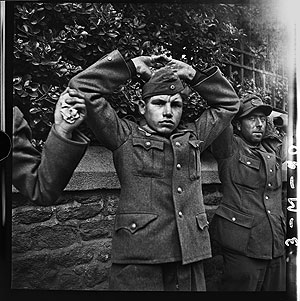My self-appointed task was to go out and work with the different pool photographers on a daily basis. The fighting on the beach was finished but there was lots of fighting very close by. I felt it was my job. Here I was assigning people to cover the war at risk of life and I figured I should share it.
Morris’ story — along with the dozen rolls of 120mm black-and- white film he shot with a borrowed company 6x6 Rollei camera over the next four weeks — has remained in a drawer ever since, with the exception of a few single images. At ninety- seven, he is finally revisiting this neverbefore- published history.
Comprised of Morris’ memoir of the summer of France’s liberation, his square-format photographs, contact sheets, and nine letters he wrote from “Somewhere in France” to his wife Mary-Adele back in New York where she was raising their two children, the book provides a new first-hand witness to the aftermath of the terrible battles for the Norman towns, the pockets of German resistance, and the continuing aerial bombardment by the US Eighth Air Force and the RAF, which caused, near Saint- Lô, the most deadly case of friendly-fire in American military history, which Morris by chance narrowly escaped.
After landing on Utah Beach near Sainte-Mère-Eglise on July 19, bearing the high flying title: "Acting Coordinator, Press Photographers, Western Front," Morris set out to assist whichever of the "pool" photographers he could — i.e. those affiliated to the three major wire-services and to Life : the Brit, George Rodger, and the Americans Robert Landry, Ralph Morse, David E. Scherman, and Frank Scherschel. Ernie Pyle, the legendary war correspondent, was around. And so was Ernest Hemingway. And then, of course, there were the adventures with his colleague, and soon-to-be friend, Bob Capa:
Capa and I had gone to a command post, the furthest forward. There was an artillery commander there, a West Pointer, who couldn’t make up his mind whether to order another barrage or try to talk the Germans into surrender. Capa said, “Why don’t you ask the Germans what they want.” And the artillery commander said, “I don’t speak German.” So, Capa offered to walk into the German lines and ask the Germans whether they wanted to be shelled or not. Capa gave me his camera. He said, “You stay here. You’ve got kids.”
Morris’ journey led him to Carentan, Isigny, Marigny, Mortain, Avranches, Rennes, Saint Malo, Dolde- Bretagne and Mont Saint-Michel — village and town names etched into history — as he watched the liberation unfold in real time, and his editor’s eye caught fresh details: horse carts and laundry, a smiling butcher who’s not supposed to sell meat to the Allies, correspondents typing their dispatches, a French woman being spat upon because she is suspected of having a German lover, black GIs, the regrouping of freed "Tirailleurs Sénégalais" troops (from the then French West-African colonies) and, among the prisoners, in the place of fierce Germans, often terrified teenagers, almost children.
Seventy years later, the result is a new story from the greatest upheaval of the 20th century, told by a young man new to war. As first-hand witness to the giants of photojournalism at work, it is also an important and very personal addition to the history of photography. Edited by the award-winning Robert Pledge, editorial director of Contact Press Images, Somewhere in France is a tribute to a crucial time and place, when the tide of history turned.
 |
 |
 |
Book Data:
ISBN: 2501095707
ISBN-13: 978-2501095709
Format: Hardcover 168 pages
Published By
Marabout (France)
April 9, 2014
Edited by Robert Pledge
Copyright © 2014 John G. Morris
Represented by
Contact Press Images